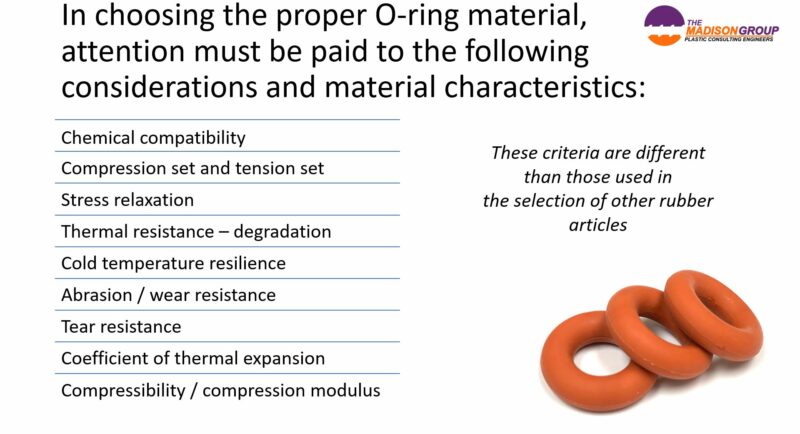I was helping a client select a plastic material for a piece of industrial equipment. I was involved deeply in the project, assisting them with a variety of plastic components. Selecting the proper material based upon the service requirement is essential for avoiding premature failure. There were six primary plastic components we were focused on, including a housing, a holding tank, gears, and connectors. The material selection went relatively smoothly for these, identifying some materials that offered both performance and cost benefits. Reviewing the assembly design, however, I noticed an O-ring, which would play in integral part in the sealing of the device. I asked my client about this and about material selection for this O-ring. His response was disappointing, but not surprising, “It is just an O-ring – we will just pick something from a catalog”.
While underappreciated, O-rings, play a critical role in many diverse equipment and component applications. An O-ring is a means for closing off a passageway, preventing escape or loss of fluid, either liquid or gas. Failure of an O-ring can have devastating consequences, and as such, the design of the sealing system and the O-ring material selection are very important. In choosing an O-ring material, it is important to consider several factors including applied pressure, the service temperature range, and the chemical being sealed. Oftentimes, balancing the requirements placed on an O-ring can be difficult, and result in a best-case compromise when it comes to material selection. There are many choices for O-ring materials, and they can be manufactured from a wide range of elastomeric materials, both thermoset rubber and thermoplastic elastomers, to provide functional and durable sealing systems. Too often, as typified by the client I discussed above, the number and variety of material selection criteria are often overlooked by system designers, which can lead to premature failure.
In choosing the proper O-ring material, attention must be paid to the following considerations of material characteristic in order to avoid loss of seal and subsequent premature failure of the component:
- Chemical compatibility
- Compression set and tension set
- Stress relaxation
- Thermal resistance – degradation
- Cold temperature resilience
- Abrasion / wear resistance
- Tear resistance
- Coefficient of thermal expansion
- Compressibility / compression modulus
These criteria are different from those used in the selection of other rubber articles, and particular care must be taken in choosing the right O-ring material. Do not underestimate the importance of proper O-ring material selection. Selecting the proper O-ring material can help to avoid component failure.

For more information on how O-rings can fail, see the post O-ring Failure Modes.
